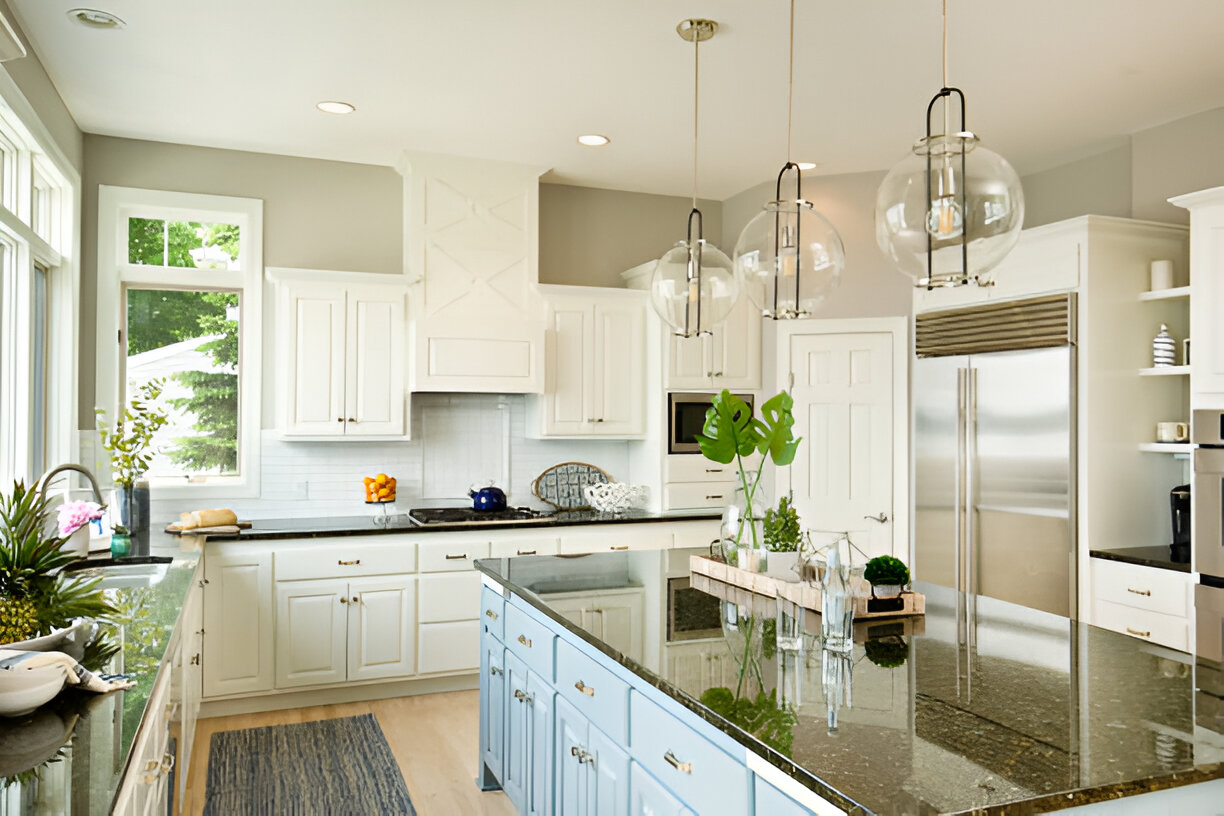Transform Your Kitchen: A Step-by-Step Guide to Cabinet Refacing
To transform your kitchen, start by evaluating your current cabinets for stability and safety, making sure they’re free from major damage and suitable for refacing. You’ll then choose materials that balance aesthetics with durability, such as veneer or laminate, considering both your budget and design preferences. Next, gather essential tools like a tape measure, screwdrivers, and a utility knife. Prepare your workspace by clearing counters and protecting surfaces. Attach new veneers and hardware meticulously, and round off with final adjustments to doors and drawers. Following these steps guarantees a fresh look with increased home value. Curious about maintaining your refaced cabinets’ charm and functionality? There’s more to explore.
Assessing Your Current Cabinets
Before you decide on refacing your cabinets, it’s important to thoroughly assess their current condition. You need to determine if they’re a solid candidate for refacing. This isn’t just about aesthetics; it’s about safety and functionality, too.
Start by inspecting the cabinet structure. Are the frames sturdy? If you notice any signs of severe water damage, such as warping or mold, or if the wood is crumbling, refacing isn’t advisable. These issues can compromise the safety and integrity of your cabinetry, making complete replacement a safer choice.
Next, check the hinges and hardware. Are the doors hanging properly? Loose or rusty hinges can pose risks, especially if the doors might fall off. It’s crucial to replace faulty hardware before considering refacing to guarantee everything operates smoothly and safely.
Also, evaluate the interior of your cabinets. If the shelves are sagging or if the interior is severely scratched or stained, assess whether these issues can be remedied without a full replacement. Remember, the goal is to not only make your kitchen look new but to ascertain it’s a safe and functional space.
Safety isn’t just a priority; it’s a necessity. Make sure your cabinets are up to par before moving forward.
Choosing the Right Materials
Once you’ve confirmed that your cabinets are structurally sound and ready for an upgrade, selecting the right materials for refacing becomes your next step. It’s essential to choose materials that not only look beautiful but are also durable and safe for your home environment.
Here’s a quick guide to help you compare the most common materials:
| Material | Pros | Cons |
|---|---|---|
| Veneer | Cost-effective, easy to apply | Less durable than other options |
| Wood | Timeless look, durable | Can be expensive |
| Laminate | Diverse styles, affordable | Can peel over time |
| Acrylic | Sleek, modern finish | Higher cost, prone to scratches |
| Thermofoil | Seamless finish, easy care | Heat sensitive, may delaminate |
Wood, for instance, offers a classic appeal and longevity, making it a great choice if you’re looking for something that’ll last. Laminate and veneer are more budget-friendly and come in various designs, allowing you to update your kitchen without breaking the bank. However, they might not withstand heavy usage as well as wood.
Safety is also paramount. Verify the materials you choose do not emit harmful chemicals. Always go for certified products that meet safety standards to guarantee your kitchen remains a safe haven. This investment in quality materials guarantees your kitchen remains both functional and a joy to use for years to come.
Gathering Necessary Tools
After choosing the right materials for your cabinet refacing project, you’ll need to gather the necessary tools to guarantee a smooth installation process. First, make sure you’ve got a sturdy tape measure and a level; accuracy is essential, and these will help you confirm everything fits perfectly. A good set of screwdrivers is necessary, both Phillips and flathead, to adjust or remove hardware. Don’t forget a utility knife for trimming veneers or laminates meticulously.
You’ll also need a drill with various drill bits for making pilot holes, which is important for preventing wood from splitting. A set of clamps will be your best friends to hold materials firmly in place while you work. It’s also wise to have a hammer and rubber mallet handy—these are indispensable for adjustments and to gently tap surfaces without causing damage.
For your safety, invest in a pair of safety glasses and work gloves. These will protect your eyes and hands from splinters, dust, and accidental slips. Remember, keeping safe doesn’t just mean working carefully; it also involves using the right protective gear to avoid preventable injuries.
With these tools ready, you’re set to move forward confidently and safely in your cabinet refacing endeavor.
Preparing the Workspace
To guarantee a successful cabinet refacing project, start by preparing your workspace thoroughly. First, clear your kitchen counters, stovetop, and sink area. You’ll need a clean, uncluttered space to work efficiently and safely. Remove all items from your cabinets and store them in a safe place. This not only gives you free access to the cabinets but also protects your belongings from dust and damage.
Next, lay down drop cloths or old sheets to protect your floors and countertops. This step is vital as it prevents scratches and stains from tools and materials you’ll be using. Make sure the cloths are secure and won’t slip, creating a tripping hazard.
Then, set up adequate lighting. Good visibility is essential for precise work and helps you avoid mistakes. If your kitchen isn’t well-lit, bring in additional lamps or a portable work light.
Installing New Veneers and Hardware
With your workspace ready, it’s time to tackle the installation of new veneers and hardware. First, verify your cabinet surfaces are clean and smooth. Any bumps or irregularities can cause the veneer to adhere improperly, creating potential hazards later on. Carefully measure and cut the veneer sheets, leaving a bit of extra margin for error. It’s better to trim excess later than to fall short.
When applying the adhesive, be generous but precise. Spread it evenly to avoid bubbles that could weaken the bond. Press the veneer firmly onto the cabinet surface, starting from the center and moving outward to push out any trapped air. Use a roller or a smoothing tool to secure the bond and guarantee a flat, safe surface.
Next, it’s time to install the new hardware. Choose handles and knobs that are sturdy and feel comfortable in your hand. When drilling new holes, double-check your measurements to avoid misalignment. Screw the hardware in tightly, but be careful not to strip the screws. A secure fit guarantees that handles won’t come loose unexpectedly, which is vital for safety and durability.
Adding Final Touches
Once you’ve installed the new veneers and hardware, it’s time to add the final touches that will bring your cabinet’s look together. Begin by verifying all surfaces are clean and free from dust or adhesive residue. Use a soft, damp cloth to wipe down the cabinets gently, avoiding harsh chemicals that could damage the finish.
Next, consider the alignment of your doors and drawers. Check that each one closes smoothly and sits flush against the cabinet frame. If you notice any misalignment, adjust the hinges slightly until everything is perfectly aligned. This not only enhances the appearance but also guarantees that the doors and drawers function safely and efficiently.
Adding soft-close dampers to your cabinet doors can be a game changer. They prevent doors from slamming, reducing wear and tear, and minimizing noise—a particularly valuable addition if you have young children or seek a serene kitchen environment.
Lastly, step back and review your work from different angles. This perspective helps you spot any inconsistencies or minor adjustments needed to achieve a polished look. With these final tweaks, your kitchen cabinets will not only look stunning but will also be a reflection of your attention to detail and commitment to quality.
Maintenance and Care Tips
Maintaining your newly refaced cabinets is essential for preserving their beauty and extending their lifespan. Regular upkeep isn’t just about aesthetics; it also guarantees your kitchen remains a safe and welcoming space for your family.
Firstly, be gentle when cleaning. Harsh chemicals can damage the finish of your cabinets. Instead, use a soft cloth and a mixture of mild soap and water. Wipe in the direction of the wood grain to prevent scratches. After cleaning, make certain to dry the surfaces completely to avoid moisture damage.
Additionally, treat your cabinets to a regular check-up. Tighten any loose screws and adjust hinges as necessary to keep doors hanging properly and guarantee smooth operation. This proactive approach prevents wear and tear and maintains the integrity of your cabinets.
To protect the wood, consider using cabinet liners in areas prone to spills, like under the sink. These liners not only catch drips but also make clean-up a breeze.



